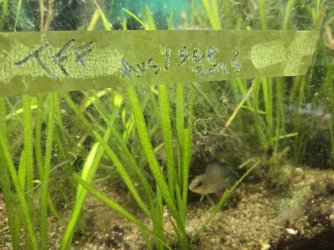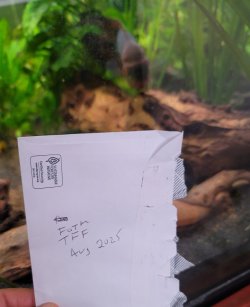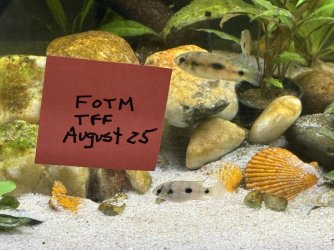You’ll see more colourful Cichlids than Parananochromis brevirostris (Lamboj & Stiassney, 2003), but you won’t see many rarer in the hobby than this small dwarf. My friends and I had to go all the way to Gabon, in Central Africa, to get this pair’s parents.
This may be one of the only breeding pairs of this fish born in aquariums. I’d love for that to change, but in this one fish we have the story of a lot of dwarf Cichlids new to the hobby. They are often kept by a small number of aquarists, and can be hard to find. With 1760 Cichlid species in this vast family, some get left behind in our tiny hobby.
To begin, this fish isn’t easy to breed. You need very soft and cool water. They don’t like life above 22-23 degrees, as their forested streams and rivers are shaded by the rainforest canopy and don’t get a lot of sun. You can kill this fish with a heater.
You need lots of plants and caves, and in spite of the small size of the fish (larger males reach 7-8cm), a fair amount of space is called for. Until the pair really forms, they can be aggressive to each other. As with the related Nanochromis species from the Congo region, there is a ferocious testing period in their courtship, but once (if) they connect, they are generally peaceful.
They are very secretive. They spawn in caves, but will try to fool you into thinking they haven’t. Some dwarf cichlid females wall themselves into caves, but these ones stay around the cave a lot tending to the eggs, but acting as if they aren’t there. One of my females (I’ve bred one wild and two captive raised pairs) would actually visit an empty cave, to try to put predators off target.
Brood care is excellent, with both partners participating, although the female does most of the work. They have between 20 and 40 fry, and care for them for months.
Apistogramma breeders will question that timeline, but unlike most Cichlids who expect juveniles to get lost when it’s time to spawn again, these fish have been tolerant of older young. I’ve kept them in 24 and 36 inch tanks, and fry have grown to young adulthood with the pair, and younger fry, When males mature though, all bets are off and young males will be killed.
The limiting factor on these fish is sex ratios. All breeders have reported male heavy broods. In a spawning of 30 fry, you are lucky to get one or two females. I’m working on understanding what we’ve been doing wrong, but I haven’t figured it out yet. Right now, this species is using seven aquariums, as I try to sort out possible females and to try different set ups. Sex is determined in the first few weeks – by the environment working with genetics.
The environment... Humanity’s current madness in wanting to invest in gold is brutally destructive of fish habitats, as gold mining is a major destructive force. These fish were caught in a river I thought nothing could still be alive in, as silt had turned the water almost opaque and yellow. The digging, rinsing and use of mercury in the process are driving extinction of fish that only live in a few places, like these ones.
Cichlids are losing popularity, and that's a shame. They are hard to beat when it comes to complex behaviour and interesting social lives. Their diversity is wonderful, as I hope we'll see in this month's "contest" (which is really a show of possibilities for other fishkeepers).








